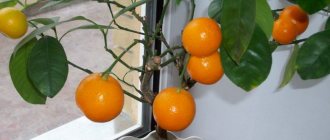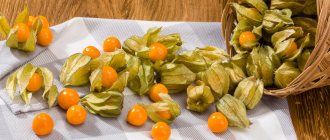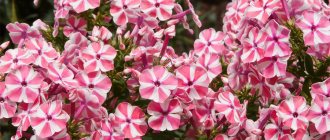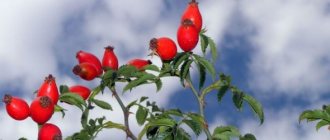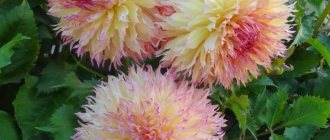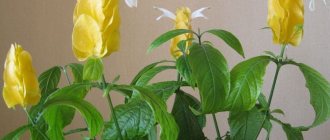Why grow?
At home, the orange plant performs several functions:
- decorates the interior
- improves the air quality in the home
- gives children (if any) the opportunity to learn hands-on how to care for citrus fruits
- you have the opportunity to taste a real orange, freshly picked from the branch
But, meanwhile, even experienced lovers of house plants do not dare to start this plant because of its possible complexity and relative decorativeness. In addition, you need to wait several years for fruiting.
young tree
Although one can argue about the beauty of the orange tree: its foliage is very bright, glossy, and with the help of shaping you can achieve a beautiful crown. So, even without fruits, it will look very worthy among flowering and decorative foliage houseplants.
Start growing an orange not by buying a ready-made tree hung with beautiful fruits, but by planting an ordinary seed from an ordinary orange. If you lack experience, you may not be able to cope with a store-bought “miracle”.
Citrus trees imported from abroad or grown in Russian greenhouses are kept on stimulants for many years and grown at constant temperature and humidity. Therefore, once in our apartments, such plants begin to rapidly fade away. Only experienced hands can save them.
Diseases
Oranges are susceptible to many fungal diseases. But it is usually weak plants that are poorly cared for that get sick. The most common fungal diseases are root rot, sooty fungus, scab and warts.
Root rot occurs due to excessive soil moisture and stagnation of water in the pot. The disease develops unnoticed until the plant begins to rapidly lose leaves. The tree can only be saved by transplanting it into a new substrate. Rotten roots must be removed.
Sooty fungus appears on leaves and branches in the form of a black coating. It can be dealt with by removing plaque and ventilating the room. It is also necessary to reduce the intensity of watering.
Dark bumps form on the leaves of oranges affected by scab . Leaves fall and the bark on affected branches cracks.
To combat the disease, copper sulfate, Bordeaux mixture and other fungicides are used. Spraying is carried out in the spring and after flowering. Diseased leaves and branches are cut off and burned.
Wart is a fungal disease in which growths form on the shoots of a tree and gray warts on its leaves. Sick branches die. To combat the disease, Bordeaux mixture is used, which is sprayed onto the crown after wintering, after flowering and in mid-summer.
Orange trees are affected by almost all known pests of indoor plants. Plants suffer most from scale insects. If pests are detected, the plant must be immediately sprayed with insecticides.
How did you get to Russia?
Oranges were brought to Russia from Holland in the 17th century
It was from this time that it began to be grown at home. First - in the greenhouses of noble nobles, and then in houses, in large tubs. By the way, the word “greenhouse” comes from the French “orange”, that is, orange.
Ancient greenhouses from the 18th and 19th centuries have been preserved, in which not only oranges were grown, but also many other exotic plants. By the way, we achieved flowering and fruiting of citrus fruits. Now, on the basis of greenhouses, farms are being created that, as before, are engaged in the propagation and grafting of oranges and other citrus fruits.
Many leading countries are now growing oranges: America, Brazil, Mediterranean countries, Iran, Turkey, Egypt, India and traditionally, for 3-4 thousand years, China. Orange production is not falling, but vice versa. Over the last 30-40 years alone, their production has doubled.
Useful tips on the topic
Advice from experienced gardeners will help make it easier to grow oranges and get a rich harvest :
- If in winter the plant is left at a temperature below +10°C , watered 1-2 times a month and not fed, then in the spring, when care resumes, it will grow faster. This will speed up the appearance of fruits.
- plants are also grafted onto oranges
- Yellowing of the leaves indicates a lack or excess of watering , lack of fertilizer or exposure to drafts on the plant.
- To reduce the risk of infection of an orange and improve its photosynthesis, once a week the leaves are wiped of dust with a damp cloth.
- Plants affected by insects are washed in a shower at room temperature.
Description of the species
Orange is a very attractive plant. However, like everything that cannot grow in our latitudes. They began to describe it from the beginning of the 19th century.
Botanists who have encountered orange trees in the wild have been impressed for a long time. The orange tree is a long-liver. There are specimens that have lived up to 150 years.
Let's not forget that every year trees bear a huge amount of tasty and healthy fruits. One orange in a good year can produce 30-40 thousand fruits. The amount depends on the age of the plant.
orange leaves
The height of the tree reaches 6 meters in height, at home it is 3 times less. The crown of the orange is very beautiful. The leaves are regular lanceolate in shape, like all oranges. They are glossy and dark green in color.
orange blossom
White flowers have a special beauty. They are white, less often pink, extremely fragrant and arranged in clusters, sometimes singly. The flower consists of a perianth covering many stamens and five petals.
The fruits consist of several nests, each of which contains seeds. Orange, like tangerine, unlike some other citrus fruits, is easily divided into lobes, each of which contains one or two seeds.
The orange peel has 2 layers:
- flavedo (yellow), outer
- albedo (white), internal
Inside the outer layer there are many glands that contain essential oil.
All citrus fruits have an albedo layer. But, for example, in lemon it is dense, which does not allow peeling, and in orange it is weak and loose. This allows the peel to be easily separated from the fruit.
The pulp of an orange differs, like that of all citrus fruits, in its originality and complex structure. It consists of elongated sacs containing juice. You can observe that if you do not cut the fruit, but only open it, then the juice does not flow out.
This happens because the juice sacs are not disturbed.
How to grow a tree from a seed
orange seeds
You can try to plant more than just an orange from a seed. But also lemon, persimmon or avocado. You just won’t get fruit from these indoor plants. Quite beautiful trees will please the eye, but only with foliage. Citrus fruits are a pleasant exception.
Why do you need a rootstock?
An inquisitive beginner who has never planted anything is faced with the question: if you plant an orange seed, what will grow? Moreover, the orange is the most ordinary one, from the nearest supermarket. The answer is yes. We will tell you how to do this below.
But we don’t need an orange seedling, but a rootstock. What does it mean? When we buy a ready-made tree with orange fruits in a flower shop, we do not even suspect that it is grafted. In 99% of all cases, the scion and rootstock are different types of citrus fruits.
Citrus grafting
All citrus fruits are grafted, otherwise, grown from seeds, they will bear fruit late (if this happens at all) and the fruits will not be as tasty. Quite often you can hear or read on specialized forums a story whose fragments are similar.
It’s about the fact that at work there is a huge lemon (orange, tangerine) grown from a seed, which is already 15 years old (10, 20, 30). And no one has ever seen it bloom. Accordingly, this tree also never indulged in fruits.
If you want your efforts not to be in vain, immediately find a good rootstock for your future tree. They can be found through advertisements. But the search will be much more effective on specialized sites, where people who are passionate about growing citrus fruits share their experience and excess planting material.
Which citrus fruits are best to plant for rootstock?
In order for citrus fruits to bear fruit, they need to be grafted. For example, kumquat or calamondin are never planted with seeds as rootstocks. Firstly, they are too frail and take a long time to grow.
Secondly, the root system of these seedlings is very weak. Both callus take a long time to grow. In a word, they are not used in this capacity.
It is believed that the best rootstocks for orange are:
- lemon
- pomelo
- bigardia or sour orange
- grapefruit
The fact is that various factors are taken into account, such as growth rate and others. Lemons are most often used, simply because they are more accessible. Than all other types of successful rootstocks.
One-year-old lemon seedlings
Two more circumstances that are taken into account when choosing a rootstock. It must have a powerful root system in order to fully feed itself and feed the scion. And another important thing: callus should grow quickly and the wounds should heal within a short period of time.
Some people call New Georgian lemon as a successful rootstock for orange. It, like bigardia, is ready for grafting within a few months after planting. And not in a year, like a lemon.
Its root is powerful and it grows callus instantly. One of the best options for rootstock. There are many opinions regarding grafting of citrus fruits. Some people like grapefruits as a rootstock because they have fairly vigorous shoots.
Some people categorically reject them for use in vaccinations. The best way to find out who is right is to experiment with grafting yourself.
How to prepare a seedling for grafting
Previously, it was believed that the rootstock should be as thick as a pencil. Now smaller barrel diameters are allowed. Hobbyists who have achieved virtuosity in matters of grafting graft citrus fruits with a trunk as thick as a match.
For successful grafting, take one-year-old lemon seedlings or 4-5 month old sour oranges. Some people apply a higher dose of nitrogen fertilizer to help the seedlings grow faster. This should not be done.
Because exceeding the dose of any element, including nitrogen, has the same negative effect as its deficiency.
Excess fertilizer is harmful to potted plants
Among the disadvantages of this method is the increased susceptibility of the plant to fungal diseases. If the excess nitrogen is large, this will also affect the appearance of the plant: the color of the leaves and trunk will change, they curl and become stained.
The best way to grow a healthy plant is to use a complete fertilizer, which contains the entire set of basic elements and microelements. In order for the lemon to grow and develop better, you can occasionally spray it with Epin to use the plant’s internal reserves.
Watering should be moderate. The soil should be slightly moist. If there is too much water, the roots will begin to rot. Outwardly, this will not appear immediately, but such a plant as a rootstock will be of little use. After all, roots are the main organ for feeding a plant.
We prepare everything for planting
Gardener's Tool Set
For beginners, you can take lemon seeds. If you really want to grow an orange from a seed, then you can do it. Orange can also be grafted onto orange rootstock. However, you will have to wait a little longer than a lemon, about a year and a half.
In order to plant citrus seeds, we need:
Plastic cups
Containers for soil
Some people specifically buy transparent cups so that they can observe the development of the root system.
Drainage
It is used to allow excess moisture to escape through the drainage hole. In the absence of drainage, excess moisture does not come out, but accumulates in the lower layer of soil and can sour there.
Pebbles or small expanded clay are used as drainage
The latter is sold in flower shops in bags labeled “Drainage”.
Priming
It is best to use the one where the name says: “For citrus fruits.” To improve germination, you can add river sand to the soil. It must first be calcined in the oven (20-30 minutes) or in the microwave (5 minutes).
Packaged soil
If you use self-prepared soil, then you must definitely use sand. Your soil must also be calcined so that all spores of fungal infections die. It is not necessary to use highly nutritious soil for sowing.
Additionally: potassium permanganate, watering can, water for irrigation, marker for signature, plastic bag, fluorescent lamp or phytolamp.
Seeds must be pre-soaked
In order for the seed to germinate faster, you can first soak it. Seeds of any plants are soaked in a small amount of water so that it barely covers the planting material. Otherwise, the seeds may “suffocate” and not sprout.
What is better to use for planting: pots or plastic cups? There is no unity in answering this question; each method has pros and cons. But most still prefer to use glasses.
They are smaller and the soil in them will not have time to sour. As soon as the root system has entangled the entire earthen ball, you can transplant the plant into a larger container. And in a pot, the root will take a long time to master the entire volume, which will slow down the development of the above-ground part.
Planting seeds
You can plant 2 or 3 seeds in a large pot at once.
You can soak the seeds in a weak solution of potassium permanganate for 15-20 minutes to disinfect the planting material.
The landing algorithm is as follows:
- Drainage holes are made in the cup with a hot metal object, usually a nail.
- Usually 2-3 holes are enough.
- Pour drainage into the bottom, approximately 1/5-1/6 of the height of the pot.
- Then add soil.
- We leave it for several hours so that it settles.
- Usually this procedure is done simultaneously with soaking the seeds.
- Just during this time the earth will settle and it will be possible to begin planting.
- In addition to soaking for several hours, you can leave the seeds in a damp cloth to germinate.
- The fabric should be washed every day in clean water and not allowed to dry out.
- After 2-3 days, the seeds (or seeds) can be planted.
- Before planting, make a small depression in the center of the pot or glass and spill a little water.
- The soil should be only slightly moistened, but in no case should the so-called “swamping” be allowed, when the soil turns into mud.
- If the soil has settled too much, add fresh soil.
- Plant the seed to a depth of 2-3 centimeters.
- After planting, sprinkle loose soil on top and do not water again.
- There should be enough moisture.
- If the seed has a “beak”, that is, a small sprout, when planting, point it down, this is the root, the cotyledon leaves will appear later.
- After planting, cover the cup with a plastic bag.
- There should be space between the soil surface and the bag.
- A so-called mini-greenhouse is formed.
- The air humidity in it should be increased to speed up germination.
- Shoots will appear in 2-3 weeks.
- How quickly this happens depends on many factors.
- First of all, this is pre-sowing treatment.
- If you pre-soaked and germinated your seed, then you may be pleased with the seedlings within a week.
- If there is no time, they can also plant dry seeds.
- In the best case, the sprout will appear in a month.
- Until this time, you can keep the pot even in a dark place.
- The main thing is to check it regularly, at least three times a day.
- The bag must be removed at least once a day and ventilated for 15-20 minutes.
- You also need to monitor the soil and seedlings.
- As soon as a sprout appears, the bag must be removed and the plant placed in the sun or under a lamp.
- You can wear the bag at night for some time, for example, a week.
When germination, the soil should always be slightly moist. Check not the surface of the soil, but a little deeper. Place your index finger on 2 phalanges. If you feel damp, then everything is in order, you can wait with watering.
How to fertilize indoor orange
The best fertilizers for oranges are ready-made balanced fertilizers purchased in specialized stores. The working solution is prepared according to the instructions and used immediately, unless a storage period is specified. The main rules of feeding:
- It is better to under-fertilize than to over-fertilize - an orange can be seriously damaged by too much fertilizer, and an “underfed” plant will end up with a slight illness.
- Fertilizing is carried out after watering so as not to burn the roots.
- After transplantation, the plants are fertilized after 1.5–2 months.
Weak and sick oranges are not fed. Fertilizer application is also limited:
- from the beginning of fruit setting and increasing them to the size of a hazel nut, so that mass falling of the ovaries does not occur;
- during the dormant period (they are stopped or reduced to 1 time per month if the plant overwinters in a warm place with additional lighting).
Regular feeding 2-3 times a month is carried out during the period of active orange growth from March to October - November. For convenience, a calendar is drawn up where the days of applying mineral, organic and complex fertilizers are noted. Choose fertilizers with equal contents of nitrogen, potassium and phosphorus, for example, from the “Fasco” series. Organic solutions (mullein, bird droppings) can be prepared independently:
- The container is filled 1/3 with raw materials.
- Add water. After the mixture has matured, it stops foaming.
- Dilute the solution with water in a ratio of 1:10 (1:20 for bird droppings).
Between feedings, water the orange:
- growth regulators, for example, Gumi-20, Ribav-Extra;
- a pale pink solution of potassium permanganate (watering is carried out in a dark room, because potassium permanganate quickly decomposes in the light);
- infusion of wood ash (stir 1 tablespoon of ash in 1 liter of water);
- iron sulfate (1–2 g per 1 liter of distilled water);
- wood glue (2 g of glue is boiled in 1 liter of water until it becomes liquid, cool and water the plant; after an hour, loosen the ground).
As a top dressing, use banana peels in any form, pre-washed with hot water:
- Pieces of fresh skins are placed on the drainage and covered with earth;
- infusion of fresh skins - add 2-3 banana “cases” to 1 liter of water. Leave for several days, filter, dilute with water in a 1:1 ratio;
- small fragments of fresh skins are laid out on the surface of the ground and sprinkled on top.
Fertilizing an orange with banana peels is an idea that raises some concerns. On the one hand, banana contains a lot of potassium; fertilizer based on it has a good effect on citrus roots. On the other hand, it is unknown what chemical is used to protect the peel from spoilage and whether it can be washed off without leaving a residue. In addition, the sweet aroma will be a magnet for attracting insects.
If the orange continues to wither, apply foliar feeding, giving the roots a time out:
Recent Entries
Lilac perennials that are beautiful, compact and do not crowd out other plants Why when buying seedlings you should not take the sellers’ word for it and how to determine the age of the plant using 3 signs Tomato seedlings have turned purple or whitish: why the color has changed and how to save the plants
- The pot is wrapped in polyethylene and tied at the trunk.
- Dip the crown into a solution of nitrogen fertilizer in a spray concentration for 20–30 minutes.
What to do about fertilizer overdose
If you overdose or use expired fertilizer, the orange may get sick and drop its leaves, even healthy ones. The plant is revived by washing the soil; the top layer can be removed. The essence of the procedure is that a large volume of water passes by gravity through an earthen lump, washing away unwanted substances. The water is allowed to drain thoroughly and the pots are returned to their original place.
Surprisingly, after such washing, the water drained away much better (but my soil, one might say, is light, almost without clay), every single plant produced growth, and the strangest thing is that the leaves of the growth are of normal shape and color, even where before This caused the curves to grow due to a lack of potassium.
It feels like the soil has become more permeable thanks to long-term drainage...roots are growing much better. Yes, it’s interesting that I didn’t loosen the surface of the earth after watering, but a crust still didn’t form; on the contrary, the irrigation water drains away faster than before. Jah Boris
https://forum.homecitrus.ru/topic/1786-promyvka-grunta-vodnye-protcedury-dlia-zemli/
Caring for seedlings after germination
To make an orange feel “at home,” the same conditions are created for it as in its homeland. To summarize, orange loves heat, high humidity and sun. But everything needs moderation. For successful development, we create the following conditions for an orange or lemon seedling:
Temperature
The higher the better. In the first year of development, this rule only works for the benefit. As the plant grows and blooms, the temperature will need to be regulated differently. But this will happen only in a few years.
In winter you need to reduce the temperature to 15 degrees
At the same time, do not forget about the lighting, otherwise the plant will stretch out. And the rest of the time - 20-25 C is the most comfortable temperature for an orange. At this time, especially when the temperature rises, you need to monitor the sun.
Lighting
Diffused light would be best
Orange loves sun, but direct sunlight can cause it to dry out. Especially in the first year, when a small amount of substrate in a glass dries out in half a day.
Watering
Young assistant
Regular, but no frills. For irrigation, use only settled water or after a filter.
Spraying
Several times a day, especially in the heat.
Top dressing
It is advisable to use complex fertilizers, such as nitroammophoska, which contains three main elements: nitrogen, phosphorus and potassium.
Nitroammofoska can be used throughout the development of the orange tree
As an additional recommendation, you may be advised to keep your seedlings away from drafts, otherwise they will die. To maintain high humidity, you can place cups with seedlings in trays, where you can spread wet moss.
How to replant citrus
Orange transplantation is carried out using the transshipment method:
- during the first year of life 2–3 times;
- up to 5 years of age annually;
- from 5 years onwards the operation is carried out once every 2–3 years, but the top layer of soil to the roots is renewed more often.
The optimal time for transplantation is in January - early February.
Transshipment is carried out as follows:
- Place your palm on the ground, passing the orange stem between the index and middle fingers.
- The pot is turned upside down, the top layer of soil, which will need to be removed down to the first roots, is sprinkled on its own or scratched off. If you slightly dry the soil in the pot, the earthen lump will come out much easier and will not fall apart in your hands. This stage is carried out with an assistant.
- They inspect the earthen lump: if everything is entwined with roots, then replanting is necessary. If the roots are not visible or they are rotten, it means that the orange is planted in too large a container and needs to be transplanted into a smaller one, removing the diseased roots and dusting them with charcoal powder. If there are few roots and they are healthy, the plant is not replanted.
If the roots entwine the earthen ball, the plant needs to be replanted
- The plant is turned over and inserted into the prepared new pot, which is 2–3 cm larger in diameter than the previous one.
When transplanting, the earthen lump is not destroyed
- Fill the space between the earthen lump and the walls of the pot with fresh soil, tapping the bottom of the pot on the floor and compacting the soil, and water it. If voids remain, root growth will be disrupted, which will lead to yellowing of the leaves and even their falling. The root collar is not buried.
- After transplanting, the orange is shaded from direct sunlight for several days.
Transplanting a flowering citrus plant using the transshipment method is quite possible.
With this method, the citrus does not experience stress and retains buds, flowers and even fruits, if the latter are present at the time of transplantation. In my practice, due to force majeure circumstances, I successfully handled such plants without any negative consequences. However, it is better not to do this without an objective need. Grigorich Maistrenko Sergey
https://forum.homecitrus.ru/topic/7593-peresadka-i-perevalka-tcitrusov-kogda-i-kak-pere/
Orange grafting
In order for an orange to bear fruit, it needs to be grafted. Let's see how to do this:
You need to prepare: rootstock, orange stalk, pruning shears or blade, polyethylene or latex (in extreme cases, you can take electrical tape).
Algorithm of actions:
- Plant it yourself using our tips, or buy a ready-made rootstock.
- Purchase a branch of a fruiting orange tree from breeders or hobbyists for grafting.
- You need to buy it on the day you plant the plant.
- Before the procedure, you need to store it in a plastic bag, wrapped in a damp cloth.
There are two methods of grafting: budding (or eye) and cuttings.
- To successfully carry out the event, you need to wait for the time of active sap flow, when the bark peels off well.
- We remove the leaves from the scion.
- After grafting, we tie the graft site and water it generously.
- After 5-10 days you need to check. If the eye does not turn black, then the bud has begun to take root.
- After 3 weeks, the bandage can be removed.
- When budding, we cut off the upper part of the rootstock only when the scion bud has sprouted and taken on an “adult” appearance.
- Budding
Vaccination schedule
Vaccination is not as complicated a procedure as it might seem at first glance. In order for everything to go well, you need to act confidently.
You can “fill” your hand on young branches of any tree or shrub. You need to take ones that are similar in diameter to the citrus fruits that interest us.
When to expect fruit
The plant is grafted, among other things, so that it bears fruit more quickly. Compare: without grafting, at best, the fruits will appear in 8-10 years. And with grafting, the wait for this event will not be long; in 3-4 years the first fragrant orange flowers will appear.
Fruit ripening in an ordinary city apartment
Sometimes a grafted plant blooms in the first year, but most often this happens later. Orange flowers are self-pollinating, so there is no need to pollinate them additionally. If at the time of flowering the room temperature is above 28 C, then urgently take measures to reduce it, otherwise the pollen becomes sterile and the fruits do not set.
The fruits ripen in approximately 8-10 months. If the plant is small, then some of the flowers can be removed. When ripe, place supports to prevent the orange from falling under the weight of the fruit.
Forming an orange crown at home
In order for an orange tree to look decorative and bear a harvest of tasty fruits, pruning of the crown is necessary. Techniques for creating a crown are carried out when the citrus reaches 25-30 cm:
- In spring, the main shoot of the tree is cut down to 25 cm.
- Leave 3-4 of the strongest side shoots. They are pinched for subsequent branching.
- After a year, growth appears, which retains 2 branches of the second order. Third order shoots will emerge from them, after which the formation of fruiting branches will begin.
- Periodically control the density of the crown, removing old and elongated branches.
In the first year of flowering, it is advisable to remove most flowers and ovaries. This will help the orange tree from the seed to get stronger and grow faster. The young tree loses strength when numerous fruits are formed.
Applications of oranges
Oranges are good not only on the table, they are widely used in the food industry.
The main directions of their application:
The main orange product is, of course, juice. It is canned and sold to us in beautiful jars and boxes. The main problem: to distinguish a fake from a truly natural juice.
Fresh orange juice
In 2000, more than 2 million tons of orange juice were produced worldwide. Most orange juice was produced in America and Brazil. Delicious orange syrup is produced for the food industry.
It is sold in retail stores. It is also purchased in large quantities by food industry enterprises. Especially those that produce confectionery, candies, semi-finished products (pancakes with syrup), ice cream.
Antioxidant-rich essential oil is cold pressed from the peel.
There are two types - sweet and bitter orange oil. Oil made in Spain and Guinea is valued more than others.
It has a strong, characteristic aroma of fresh orange, making it popular in aromatherapy. Combines well with other essential oils, especially pine and lavender oils. Since ancient times it has been used in cosmetology as part of creams.
It has an anti-inflammatory, toning and regenerating effect for all skin types. Orange zest is widely used. It is rich in flavonoids, pectin, vitamins, and phytoncides.
Zest jam
It is used in making jam, as well as in the production of liqueurs. The remainder of the peel processing also does not go to waste and is used as livestock feed.
Where and for what can they be used?
Using distillation, the essential oil is removed from newly opened buds. Use it :
- in cosmetology;
- perfume industry;
- medicine;
- aromatherapy;
- in the production of alcoholic beverages;
- in cooking.
Owners can thin out a blooming orange, dry half-opened or just blossomed buds. They can be added to tea or used for sachets . Fresh flowers are candied, glazed, and used in the preparation of desserts and drinks.
Branches of a blossoming orange tree are used for the bride's bouquet. This tradition is most widespread in the Mediterranean countries.
Benefits of oranges
Orange is a storehouse of vitamins and other useful substances. It has a tonic effect; it’s not for nothing that Americans drink freshly squeezed orange juice in the morning. At a time when citrus fruits were transported to Europe by ship, the fruit was used as an antiscorbutic remedy.
In addition, the fruits are useful:
- prevention of hypovitaminosis
- treatment of vitamin C deficiency (160 grams contains the daily requirement of this vitamin)
- prescribed for liver diseases
- promotes better absorption of iron
- help improve the functioning of the digestive tract
- has a beneficial effect on blood vessels, thinning the blood
Oranges are especially rich in vitamin C. A little behind in quantity are vitamin B1, potassium and folic acid.
Due to the presence of a large amount of fiber, putrefactive processes in the large intestine are reduced. Dietary fiber enhances the digestion process.
One large fruit contains a daily dose of vitamin C
The fruit contains a lot (87%) of water and virtually no protein or fat, which makes the orange a very light product. Even though oranges contain 12% carbohydrates, which are in the form of simple sugars, they have a low glycemic index.
Plus: for all their benefits, they are very tasty!
How best to consume: juice or fruit
Orange juice is the leader in popularity in all countries, but, like any juice, it contains much less fiber compared to fruits. Its glycemic index increases slightly due to the lack of fiber. One glass of orange juice contains enough glucose to equal two whole oranges.
Let's remember this, it is especially useful for those who are going on a diet. Excessive juice consumption can lead to weight gain. Good quality orange juice will only benefit you if consumed in moderation. But, if you want to lose weight, it is better to eat whole fruits.
Juice or fruit?
As such, adverse effects from consuming oranges are rare. “Torture” with oranges is unlikely to harm a healthy body. Only a small number of people are allergic to citrus fruits. Pregnant women are advised to drink juices and eat the fruits themselves with caution.
Orange is highly acidic due to the content of citric and ascorbic acids and can be annoying for those who suffer from heartburn. And it doesn’t matter in what form it will be eaten.
Otherwise, this fruit, beloved all over the world, is the standard for combining business with pleasure - tasty, nutritious, simply a storehouse of antioxidants, flavonoids, vitamins, minerals, and so on. All this really helps prevent cardiovascular and kidney diseases. Overall, delicious and healthy food!
Citrus diseases and their treatment
Untreatable orange diseases include:
- tristeza - in a mild form the tree loses its leaves, in a severe form it dies entirely;
- leaf mosaic - the leaves become covered with light or dark stripes, become deformed, and the growth of the orange slows down. Good care and feeding stop the process;
- cancer - the plant dies. To prevent the disease, spring treatment is carried out with copper-containing fungicides.
Treatable diseases include:
- anthracnose - leaves become covered with brown spots, ovaries and buds crumble, bark is destroyed, young branches rot. Spraying with a 1% solution of copper sulfate helps; cracks are covered with garden varnish; each new order of shoots is sprayed with 1% Bordeaux mixture;
- homosis - caused by waterlogging of the substrate, deepening of the root collar, mechanical damage to the bark, excess nitrogen and lack of phosphorus and potassium. Manifestations: gum leaks from cracks at the base of the trunk, the bark dies. Treatment: cracks are disinfected with potassium permanganate, covered with garden varnish, feeding is adjusted;
- iron chlorosis (iron deficiency) – leaves become discolored, flowers and ovaries fall off, shoot tips dry out. Treatment: spraying with iron-containing preparations, for example, Ferovit;
- brown spot - caused by a fungus, manifests itself in the form of small spots on the leaves. Treatment: spraying with 1% Bordeaux mixture.
